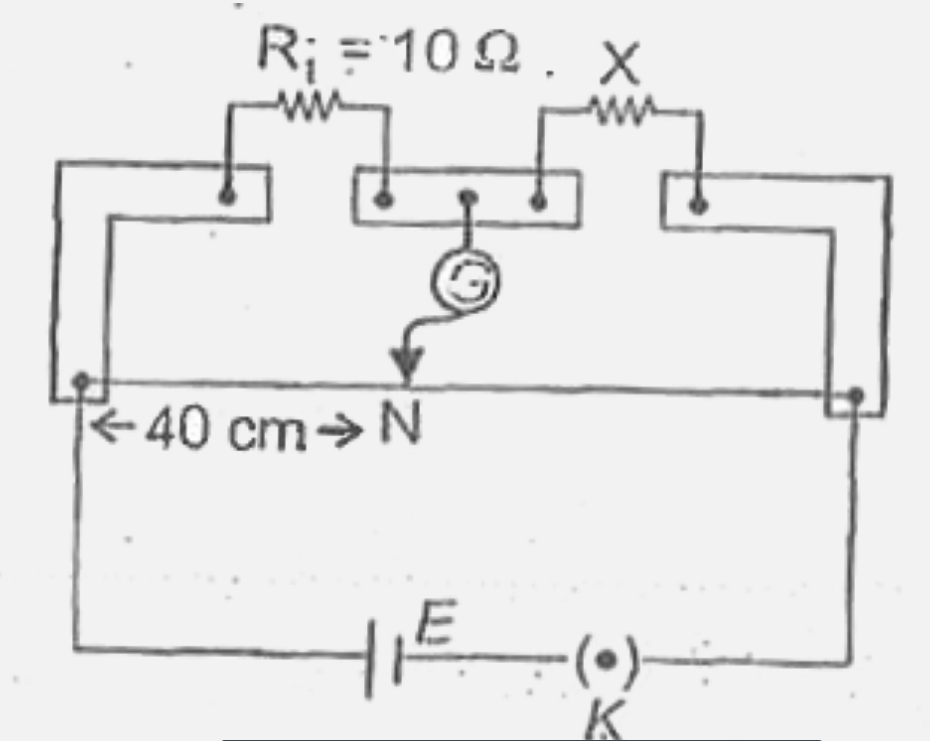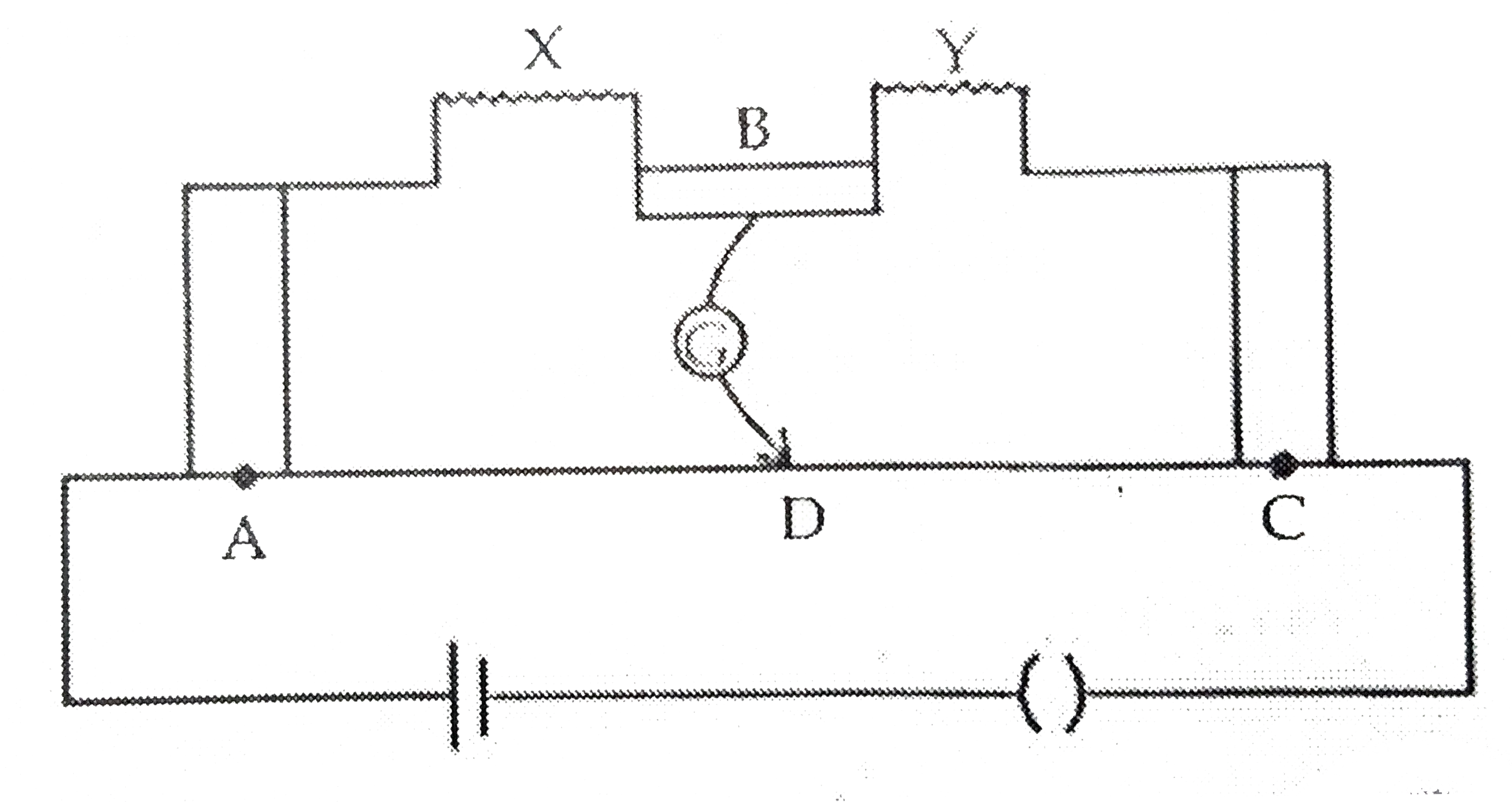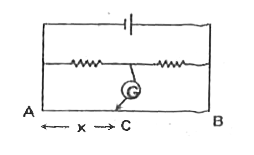In a meter bridge experiment, null point is obtained at 20cm from one end of the wire when resistance X is balanced against another resistance Y. If X<Y, then the new position of the null point from the same end, if one decides to balance a resistance of 4X against Y will be at.
50cm
80cm
40cm
70cm
The correct Answer is:A
To solve the problem step by step, we can follow these instructions:
Step 1: Understand the meter bridge principle
In a meter bridge experiment, the balance point (null point) is determined by the ratio of the resistances. The formula used is:
XY=L100−L
where L is the distance from one end of the bridge wire to the null point.
Step 2: Set up the first case
From the problem, we know that when resistance X is balanced against resistance Y, the null point is at 20cm from one end of the wire. Therefore, we can write:
XY=20100−20=2080=14
Step 3: Set up the second case
Now, we need to find the new position of the null point when 4X is balanced against Y. We can denote the new null point as L. The relationship can be expressed as:
4XY=L100−L
Step 4: Substitute the known ratio
From the first case, we know that XY=14. Therefore, we can express 4X in terms of Y:
4XY=4⋅XY=4⋅14=1
Thus, we can rewrite the equation:
1=L100−L
Step 5: Solve for L
Cross-multiplying gives us:
100−L=L
Adding L to both sides results in:
100=2L
Dividing both sides by 2 gives:
L=50cm
Conclusion
Therefore, the new position of the null point from the same end, when balancing resistance 4X against Y, will be at 50cm.
In a meter bridge experiment, the balance point (null point) is determined by the ratio of the resistances. The formula used is:
XY=L100−L
where L is the distance from one end of the bridge wire to the null point.
From the problem, we know that when resistance X is balanced against resistance Y, the null point is at 20cm from one end of the wire. Therefore, we can write:
XY=20100−20=2080=14
Now, we need to find the new position of the null point when 4X is balanced against Y. We can denote the new null point as L. The relationship can be expressed as:
4XY=L100−L
From the first case, we know that XY=14. Therefore, we can express 4X in terms of Y:
4XY=4⋅XY=4⋅14=1
Thus, we can rewrite the equation:
1=L100−L
Cross-multiplying gives us:
100−L=L
Adding L to both sides results in:
100=2L
Dividing both sides by 2 gives:
L=50cm
Therefore, the new position of the null point from the same end, when balancing resistance 4X against Y, will be at 50cm.
Topper's Solved these Questions
- EXPERIMENTSBook:DC PANDEY ENGLISHChapter:EXPERIMENTSExercise:Subjective
Explore 15 Videos
- EXPERIMENTSBook:DC PANDEY ENGLISHChapter:EXPERIMENTSExercise:Exercise 3.8
Explore 3 Videos
- ELECTROSTATICSBook:DC PANDEY ENGLISHChapter:ELECTROSTATICSExercise:Integer
Explore 17 Videos
- FLUID MECHANICSBook:DC PANDEY ENGLISHChapter:FLUID MECHANICSExercise:Medical entranes gallery
Explore 49 Videos
Similar Questions
In the metrebridge experiment , the null point is obtained at N. The value of unkonw resistance X will be .

View SolutionTwo unknown resistances are connected in two gaps of a meter-bridge. The null point is obtained at 40 cm from left end. A 30Ω resistance is connected in series with the smaller of the two resistances, the null point shifts by 20 cm to the right end. The value of smaller resistance in Ω is
View Solution
Knowledge Check
In a meter bridge experiment the ratio of left gap resistance to right gap resistance is 2:3 the balance point from is
A60cmB50cmC40cmD20cm
The figure shows experimental set up of a meter bridge. When the two unknown resistances X and Y are inserted, the null point D is obtained 40 cm from the end A. When a resistance of 10Ω is connected in series with X, the null point shifts by 10 cm. Find the position of the null point when the 10Ω resistance is instead connected in series with resistance 'Y'. Determine the value of the resistance X and Y

View SolutionIn the meter bridge circuit shown, the null point is obtained at C(AC=x) on the wire AB. If the diameter of the wire AB is doubled, the position of the new null point C' will correspond to

View SolutionIn a meter bridge, null point is 20cm, when the known resistance R is shunted by 10Ω resistance, null point is found to be shifted by 10 cm. Find the unknown resistance X.
View SolutionIn a meter bridge, null point is 20cm, when the known resistance R is shunted by 10Ω resistance, null point is found to be shifted by 10 cm. Find the unknown resistance X.
View SolutionIn a meter bride, null point is 20cm, when the known resistance R is shunted by 10Ω resistance, null point is found to be shifted by 10cm . Find the unknown resistance X.
View SolutionStatement-1 : In a Meter Bridge experiment, null point for an unknown resistance is measured. Now, the unknown resistance is put inside an enclosure maintained at a higher temperature. The null point can be obtained at the same point as before by decreasing the value of the standard resistance.
Statement-2 : Resistance of metal increases with increase in temperature.
View SolutionStatement-1 : In a Meter Bridge experiment, null point for an unknown resistance is measured. Now, the unknown resistance is put inside an enclosure maintained at a higher temperature. The null point can be obtained at the same point as before by decreasing the value of the standard resistance.
Statement-2 : Resistance of metal increases with increase in temperature.
View Solution